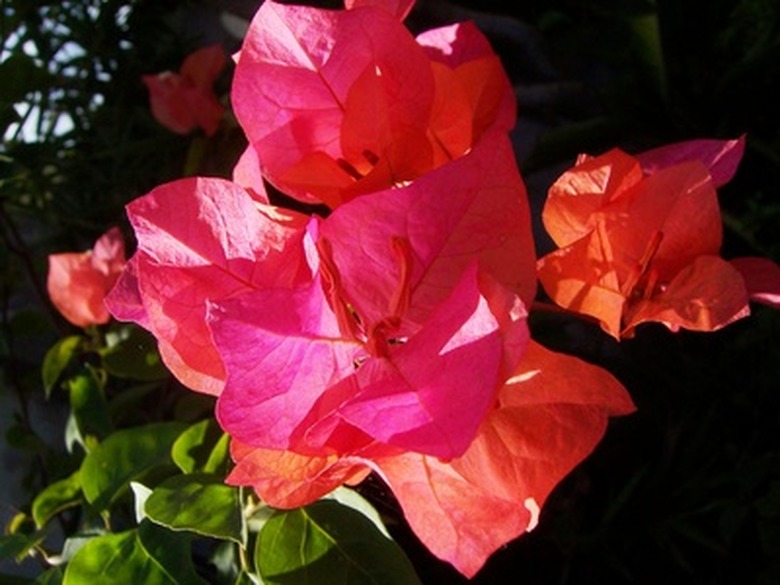How To Keep Bugs Away From Bougainvillea Leaves
Things Needed
- Mulch
- Yellow sticky traps
- Soapy water
- BT (Bacillus thuringiensis)
- Horticultural oil
- Insecticidal soap
- Neem oil
Handsome, robust and sturdy, the healthy, mature bougainvillea is undemanding and relatively pest-free. A few bugs such as aphids, looping caterpillars, thrips and spider mites may pose a threat. These will attempt to feed on bougainvillea leaves throughout the growing season. Keep a sharp eye out for them and jump on the situation immediately. Exercise a healthy maintenance program that incorporates natural controls with environmentally friendly substance applications to keep those bugs away from bougainvillea leaves.
Step 1
Inspect your bougainvillea daily for the presence of insect pests, which may be mature bugs or their larvae, or caterpillars. Look carefully at all leaf surfaces, above and below, and examine the tender new growth. Place a piece of white paper under the foliage and shake the limbs. Bugs will drop onto the paper, enabling you to identify at least part of your problem.
- Handsome, robust and sturdy, the healthy, mature bougainvillea is undemanding and relatively pest-free.
- Inspect your bougainvillea daily for the presence of insect pests, which may be mature bugs or their larvae, or caterpillars.
Step 2
Practice good plant cultural habits. Weed your bougainvilleas enthusiastically and use mulch to discourage weed development. Keep the area free of all excess plant material and debris. These efforts will deprive pests such as leaf miners and wood borers of hiding places and alternative food sources.
Step 3
Set yellow sticky traps in and near your bougainvillea's foliage. These catch all kinds of bugs–particularly aphids–and will indicate what's eating your plant so that you can treat it accordingly.
Step 4
Hand pick any bugs that you find and drop them into a bucket of soapy water. Early in the morning or just after dusk are the best times to do this. If you're really fed up with pests, exact your vengeance by squishing them between gloved fingers. It will make you feel better. You can also easily knock most bugs from the bougainvillea's leaves with a sharp stream of water from the garden hose.
- Practice good plant cultural habits.
- Set yellow sticky traps in and near your bougainvillea's foliage.
Step 5
Introduce beneficial predators to your garden. These include green lacewings and different species of ladybugs. Follow the packaging instructions carefully.
Step 6
Apply Bacillus thuringiensis, better known as BT, to your bougainvillea for killing aphids, caterpillars and some beetle species. These bacterial diseases won't affect you, your pets, most natural predators or the environment but they are deadly to specific insects. Bugs may die rapidly or simply stop eating and starve for two or three days before expiring. Choose a preparation labeled for your particular pest and follow the packaging instructions carefully.
- Introduce beneficial predators to your garden.
- Choose a preparation labeled for your particular pest and follow the packaging instructions carefully.
Step 7
Combine ¼ tsp. horticultural oil and ½ tsp. insecticidal soap with 1 quart of warm water. Wash your bougainvillea's leaves with the solution and rinse them thoroughly. This preparation is effective for thrips, mealy bugs and spider mites, which are difficult to fight with other methods. It also works well for many other types of insect pests.
Step 8
Treat with Neem oil for prevention and treatment of many insect pests. Follow the manufacturer's instructions carefully.
- horticultural oil and ½ tsp.
- Treat with Neem oil for prevention and treatment of many insect pests.
Tip
Beneficial insects can be purchased from gardening centers. BT is readily available at gardening centers. You can buy ready-to-use granules and dusts or liquid concentrates and wettable powder formulations. There are different strains of these organisms that are specific to the insect pests that they attack. Identify your bugs and use appropriate preparations labeled for targeting pests.
Warning
Protect yourself when using any substance controls. Wear sturdy clothing that covers as much skin as possible. Use gloves and eye protection, and employ a respirator if applicable. Don't apply sprays on a windy day.
